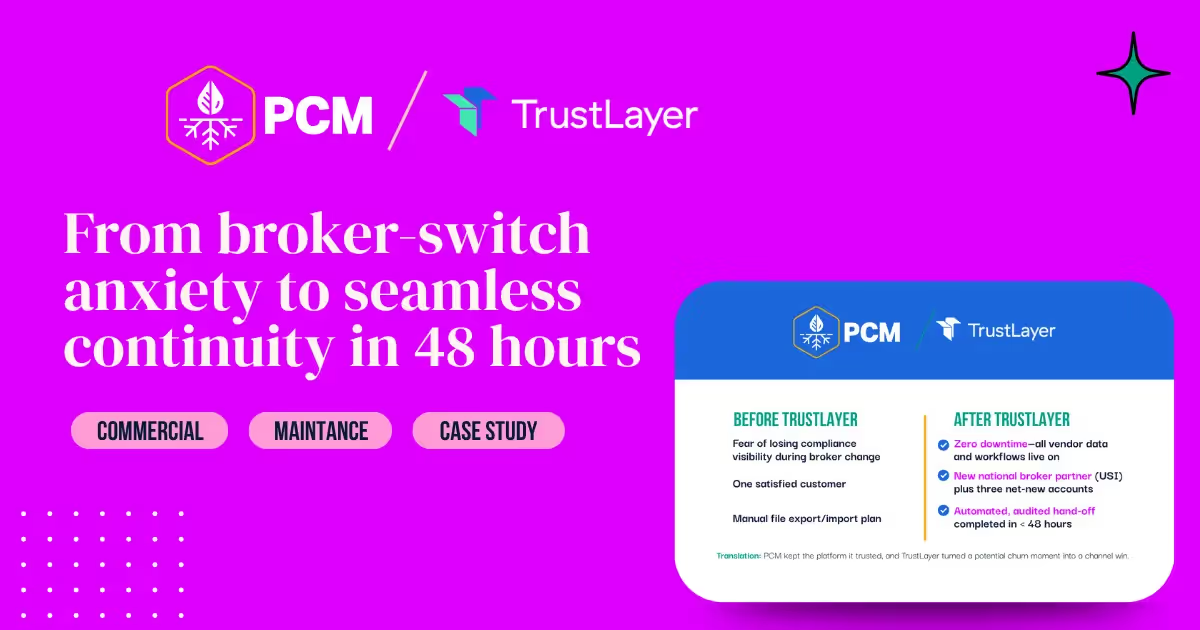A Guide to Tracking Certificates of Insurance

Tracking certificates of insurance is a crucial task for businesses and organizations of all sizes. In this guide, we will explore what certificates of insurance are, why they are important, and the risks of not tracking them. We will also examine traditional methods of tracking certificates of insurance and discuss modern solutions that can streamline the process. Finally, we will provide steps for implementing an insurance certificate tracking system and training staff for effective use. Let's dive in!
Understanding Certificates of Insurance
Certificates of insurance are documents that demonstrate proof of insurance coverage. They provide important information about an insurance policy, such as the issuing insurance company, policy number, coverage limits, and effective dates. These documents are typically requested by third parties, such as clients, vendors, or landlords, to ensure that the policyholder has the necessary insurance protection.
It is essential to understand the contents of a certificate of insurance to assess if the coverage meets the specific requirements set by the requesting party. Failure to provide accurate and up-to-date certificates can result in lost business opportunities, increased liability exposure, or even breach of contract.
What is a Certificate of Insurance?
A certificate of insurance is a document that summarizes the coverage and limits of an insurance policy. It serves as evidence that the policyholder has in-force insurance, but it does not confer any rights or alter the terms of the policy itself. The certificate provides key details about the policy, including the types of coverage, policy limits, and additional insured parties, if any. It may also include any special conditions or endorsements that modify the coverage.
For example, in the construction industry, a certificate of insurance may specify that the policy includes coverage for general liability, workers' compensation, and builder's risk. It may also detail the coverage limits for each type of insurance and list the subcontractors as additional insured parties. This information helps the project owner or general contractor ensure that all parties involved in the project are adequately protected.
Importance of Certificates of Insurance
Certificates of insurance play a vital role in managing risk and protecting businesses. They help establish trust and peace of mind for clients, suppliers, and other stakeholders by confirming that adequate insurance coverage exists. By verifying insurance coverage, organizations can ensure that they are not exposed to unnecessary risks and liabilities.
Additionally, certificates of insurance are often required to comply with contractual obligations. Many contracts stipulate proof of insurance as a condition for doing business, especially in industries where potential liability is high or where the client or project owner wants to transfer risk to another party. Failing to provide the necessary certificates can lead to contract disputes, legal issues, and even reputation damage.
Furthermore, certificates of insurance can also be used as a marketing tool. Businesses can showcase their insurance coverage by providing certificates to potential clients or partners, demonstrating their commitment to risk management and financial responsibility. This can give them a competitive edge in industries where insurance coverage is a significant consideration for clients when choosing a service provider.
In conclusion, certificates of insurance are crucial documents that provide proof of insurance coverage and important details about the policy. They serve as a means to establish trust, comply with contractual requirements, and manage risk. Understanding the contents of a certificate of insurance is essential for both policyholders and the parties requesting the certificates to ensure adequate protection and avoid potential legal and financial consequences.
The Need for Tracking Certificates of Insurance
A significant challenge faced by many organizations is the failure to adequately track certificates of insurance. This oversight can result in serious consequences, including financial loss, contractual violations, and increased risk exposure.
Let's dive deeper into the risks of not tracking certificates of insurance and the benefits of implementing an efficient certificate tracking system.
Risks of Not Tracking Certificates of Insurance
Not tracking certificates of insurance can leave businesses vulnerable to financial and legal risks. Without proper oversight, expired or inadequate insurance coverage may go unnoticed, potentially leading to costly claims and lawsuits. In addition, failure to track certificates can result in missed renewal dates, leaving businesses temporarily uninsured and exposed to liabilities.
Furthermore, not tracking certificates of insurance can damage the organization's reputation and credibility with clients. If clients discover that their certificates are not being monitored, they may question the reliability and professionalism of the business, potentially leading to lost opportunities.
For example, imagine a construction company that fails to track certificates of insurance for subcontractors. One day, a subcontractor's insurance policy expires, but the company remains unaware. Unfortunately, an accident occurs on the construction site, leading to property damage and injuries. Without valid insurance coverage, the construction company is now liable for the damages and may face significant financial strain.
As you can see, the risks of not tracking certificates of insurance are far-reaching and can have severe consequences for businesses.
Benefits of Efficient Certificate Tracking
On the other hand, implementing an efficient certificate tracking system can provide several benefits to businesses. By proactively tracking certificates of insurance, organizations can:
- Ensure compliance with contract requirements
- Minimize exposure to risks and liabilities
- Identify coverage gaps or inadequate policy limits
- Streamline insurance renewal processes
- Maintain a good reputation with clients and partners
Efficient certificate tracking can also help organizations save time and resources by automating manual processes, reducing errors, and providing real-time visibility into the status of certifications.
For instance, let's consider a manufacturing company that relies on various suppliers to deliver raw materials. By implementing an efficient certificate tracking system, the company can ensure that all suppliers have valid insurance coverage before engaging in business. This not only protects the company from potential liabilities but also demonstrates a commitment to risk management and compliance to clients and partners.
In addition, efficient certificate tracking can help organizations identify coverage gaps or inadequate policy limits. By regularly reviewing certificates of insurance, businesses can ensure that their coverage aligns with their specific needs and industry standards. This proactive approach mitigates the risk of being underinsured and provides peace of mind.
Furthermore, streamlining insurance renewal processes through efficient tracking systems saves businesses valuable time and resources. Instead of manually collecting and reviewing certificates, organizations can automate these processes, allowing for a more efficient and accurate renewal process. This not only reduces administrative burdens but also ensures that insurance coverage remains up to date without any lapses.
In conclusion, the need for tracking certificates of insurance cannot be overstated. Failing to do so can expose businesses to significant risks, including financial loss, legal complications, and damaged reputation. On the other hand, implementing an efficient certificate tracking system provides numerous benefits, such as compliance assurance, risk mitigation, and streamlined processes. By prioritizing certificate tracking, organizations can safeguard their operations, protect their assets, and maintain a strong and trustworthy business reputation.
Traditional Methods of Tracking Certificates of Insurance
Historically, tracking certificates of insurance has been a manual and time-consuming process. Two common methods include manual tracking and the use of spreadsheets. Let's explore these methods and their challenges:
Manual Tracking and its Challenges
Manual tracking involves physically reviewing and updating certificates of insurance. This method requires diligent record-keeping and ongoing communication with insurance providers and third parties. However, manual tracking is prone to human errors and inefficiencies, making it difficult to keep up with the volume of certificates and ensuring their accuracy and timeliness.
Challenges with manual tracking include misplaced or lost documents, outdated information, difficulties in accessing documents, and the inability to receive real-time updates on policy changes or cancellations. As organizations grow, manual tracking becomes increasingly impractical and risky.
Role of Spreadsheets in Tracking
Many organizations turn to spreadsheets as a digital alternative to manual certificate tracking. Spreadsheets offer more structure and organization, making it easier to manage and sort through certificate information. However, relying solely on spreadsheets presents its own set of challenges.
Spreadsheets lack advanced automation and notification features. This means that monitoring the expiration dates, requesting renewals, and ensuring compliance must still be done manually. Spreadsheets can become cumbersome and error-prone when managing a large volume of certificates, leading to delays, inaccuracies, and potential compliance gaps.
Modern Solutions for Tracking Certificates of Insurance
To overcome the limitations of manual tracking and spreadsheets, modern solutions, such as insurance tracking software, have emerged. These solutions leverage technology to automate and streamline the certificate management process.
Introduction to Insurance Tracking Software
Insurance tracking software is designed to simplify the management of certificates of insurance. It centralizes all certificate information in one secure location, providing real-time updates, automated notifications, and easy access to the latest policy documents.
With insurance tracking software, organizations can easily track and monitor certificate expiration dates, policy changes, and compliance requirements. The software can generate automated reminders for renewals, preventing any lapses in coverage. Additionally, it allows for easy sharing of certificates with third parties and provides auditing capabilities for compliance purposes.
Benefits of Using Insurance Tracking Software
Using insurance tracking software offers numerous benefits for organizations:
- Streamlined and automated processes
- Enhanced accuracy and reduced errors
- Real-time updates and notifications
- Centralized and secure document storage
- Improved compliance and risk management
- Time and cost savings
One notable insurance tracking software solution is TrustLayer, which offers an intuitive and robust platform for managing certificates of insurance. TrustLayer automates the tracking process, ensures compliance, and minimizes the risk of expired or inadequate coverage. Its user-friendly interface and advanced features make it a preferred choice for organizations seeking efficient certificate management.
Implementing an Insurance Certificate Tracking System
Implementing an insurance certificate tracking system is an essential step towards managing risk effectively. Here are the key steps to consider when implementing such a system:
Steps to Implement a Tracking System
- Assess your organization's needs and requirements.
- Select a suitable insurance tracking software or solution.
- Gather and digitize all existing certificates of insurance.
- Input the certificate data into the tracking system.
- Establish processes for ongoing monitoring and updates.
- Train staff on the new system and its features.
- Regularly review and audit the tracking system.
- Continuously improve and adapt the system as needed.
By following these steps, organizations can ensure a smooth transition to a more efficient and effective certificate tracking process, reducing administrative burdens and mitigating potential risks.
Training Staff for Effective Use of the System
Implementing an insurance certificate tracking system requires proper training of staff members who will be responsible for managing the process. Providing comprehensive training on how to navigate the software, input data, generate reports, and set up automated notifications is critical.
Training should also emphasize the importance of accurate and up-to-date certificate information, proper record-keeping, and compliance with internal policies and procedures. Regular refreshers and continuous support should be available to ensure staff members feel confident and empowered to utilize the tracking system effectively.
In summary, tracking certificates of insurance is a vital task that organizations cannot afford to overlook. By understanding the importance of certificates of insurance, the risks of not tracking them, and the benefits of efficient tracking, organizations can take proactive steps to mitigate liability and ensure compliance. Traditional methods of tracking, such as manual processes and spreadsheets, have limitations that can be overcome with modern solutions like insurance tracking software. Implementing such a system, coupled with proper staff training, can streamline the certificate management process and provide peace of mind for businesses. TrustLayer, with its advanced features and user-friendly interface, stands as an excellent choice for organizations seeking a reliable and efficient insurance tracking solution. Take control of your certificate management process and protect your business today!
















